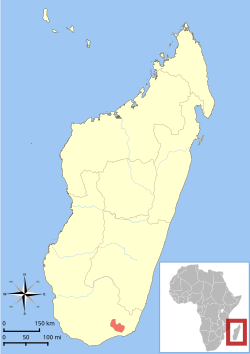| White-footed sportive lemur | |
|---|---|
 | |
| Scientific classification | |
| Kingdom: | Animalia |
| Phylum: | Chordata |
| Class: | Mammalia |
| Order: | Primates |
| Suborder: | Strepsirrhini |
| Family: | Lepilemuridae |
| Genus: | Lepilemur |
| Species: | L. leucopus |
| Binomial name | |
| Lepilemur leucopus Forsyth Major, 1894 [3] | |
 | |
| Distribution of L. leucopus [1] | |
| Synonyms | |
| |
The white-footed sportive lemur, white-footed weasel lemur, or dry-bush weasel lemur [1] (Lepilemur leucopus) is a species of lemur in the family Lepilemuridae, the sportive lemurs. It is similar in appearance to other lemurs in the family, with a grey back, a pale grey to white ventral side, and a light brown tail. [4] It is a nocturnal animal that moves through the forest using a vertical clinging and leaping technique. [5] It is endemic to Madagascar, inhabiting the southern subtropical or tropical dry shrubland. It is threatened by habitat loss due to agriculture practices and charcoal production. [1]
